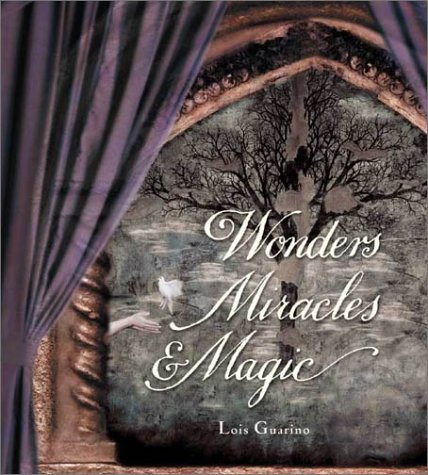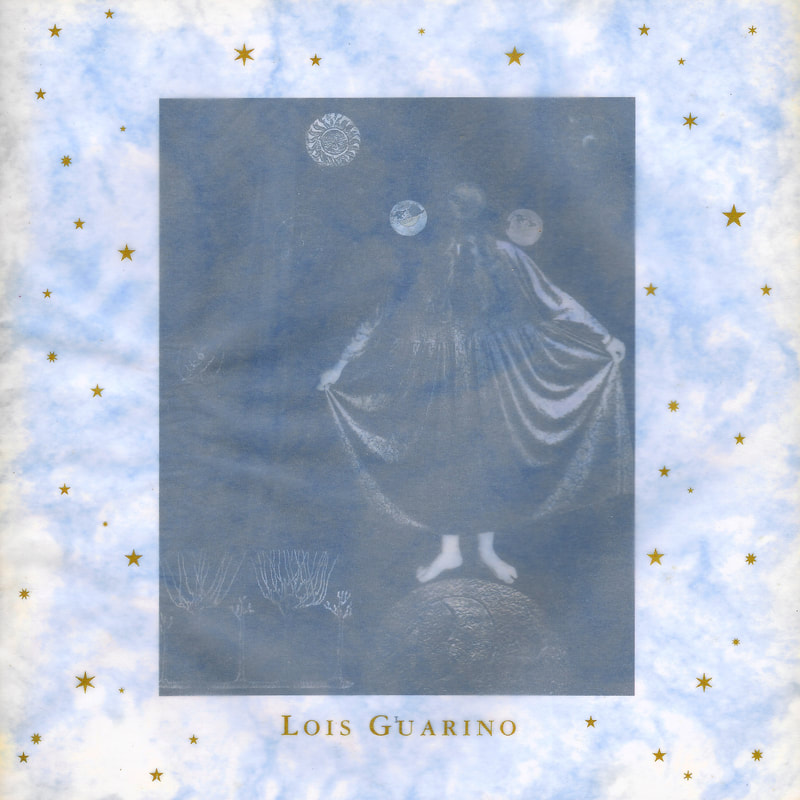Introduction to the photography book Wonders Miracles & Magic:
Wonders, Miracles,
Magic and Photography
by Ellen Handy
Lois Guarino is a magician and a chronicler of magic, a dreamer and a recorder of dreams. Her photographs are as thoroughly constructed as any sculpture, as mysterious as alchemy, as twenty-first century as digital imagery, and as traditional as manuscript illumination. Yet she is always an artist of synthesis, never of contradiction. For many years, she has used photography to explore intuitions, identity and our desire to penetrate the future.
Photography as a means of addressing the ineffable may seem unusual, but it is historically sanctioned; in 1839, one of the medium’s inventors, William Henry Fox Talbot, called it “quite a little bit of magic realized.” Prints develop in the darkroom much as the future becomes clear through divination or as messages are revealed in dreams. Guarino’s intricately wrought prints employ platinum contact printing, gilding, hand coloring, computer manipulation of scanned images, digital output of negatives – and the reverie that produces such synthesis in images – to present her elusive, associative subject matter.
In her most recent work, Guarino has approached dreams as everyday miracles. Some of the photographs depict “dream beds,” which are both derivations of dream images and hypothetical generative sites for producing dreams. In the Garden Bed, a child slumbers in an abundantly fruitful, flowering bed in a room papered with botanical imagery, and menaced by a densely interwoven carpet of undulating serpents. Lovely and threatening qualities are thus conjoined to express the emotional valences of the dream world. The role of dreams in the production of childhood identity is addressed in Livi’s Dream. A wolf poised on a chilly horizon bays at the sky, while a watchful child is caught midway in an almost Ovidian transformation between girl and wolf, as snowflakes and starlight fall on her flowing hair.
The transmutations and dream images of Guarino’s recent work are closely linked to her previous series, Predicting the Future, which depicts various practices of divination through still lifes reminiscent of cabinets of curiosities. Like all of her work, it is characterized by exquisite technique; highly constructed imagery; the use of lovingly collected objects, images and props; a combination of personal association and mythic or symbolic imagery; and an elegant flatness of pictorial space. Palmistry Chart is a particularly sumptuous image in which a palmist’s diagrammed hand model is framed and enclosed by magnificently worked metals and gems somewhere between the Victorian and the medieval in appearance. The coloring of the jewels and the sheen of the metal virtually amount to trompe l’oeil. Like all the divination images, it recalls the enduring human hunger to possess a tantalizingly remote future.
Lois Guarino’s photographs use a unique visual language to depict immaterial experiences, the mutability of the world and the self, and intersections between the personal and the universal. Dreams and photographs, divinations and visions – all use transformation and seduction, beauty and anxiety, the real and the immaterial to do their work. Guarino joins these elements in resplendent, handmade digital photographic images, which are at once expressions of affirmation and of wonder.
Ellen Handy was Curator of Collections in 2001 at the International Center of Photography, New York City.
Wonders, Miracles,
Magic and Photography
by Ellen Handy
Lois Guarino is a magician and a chronicler of magic, a dreamer and a recorder of dreams. Her photographs are as thoroughly constructed as any sculpture, as mysterious as alchemy, as twenty-first century as digital imagery, and as traditional as manuscript illumination. Yet she is always an artist of synthesis, never of contradiction. For many years, she has used photography to explore intuitions, identity and our desire to penetrate the future.
Photography as a means of addressing the ineffable may seem unusual, but it is historically sanctioned; in 1839, one of the medium’s inventors, William Henry Fox Talbot, called it “quite a little bit of magic realized.” Prints develop in the darkroom much as the future becomes clear through divination or as messages are revealed in dreams. Guarino’s intricately wrought prints employ platinum contact printing, gilding, hand coloring, computer manipulation of scanned images, digital output of negatives – and the reverie that produces such synthesis in images – to present her elusive, associative subject matter.
In her most recent work, Guarino has approached dreams as everyday miracles. Some of the photographs depict “dream beds,” which are both derivations of dream images and hypothetical generative sites for producing dreams. In the Garden Bed, a child slumbers in an abundantly fruitful, flowering bed in a room papered with botanical imagery, and menaced by a densely interwoven carpet of undulating serpents. Lovely and threatening qualities are thus conjoined to express the emotional valences of the dream world. The role of dreams in the production of childhood identity is addressed in Livi’s Dream. A wolf poised on a chilly horizon bays at the sky, while a watchful child is caught midway in an almost Ovidian transformation between girl and wolf, as snowflakes and starlight fall on her flowing hair.
The transmutations and dream images of Guarino’s recent work are closely linked to her previous series, Predicting the Future, which depicts various practices of divination through still lifes reminiscent of cabinets of curiosities. Like all of her work, it is characterized by exquisite technique; highly constructed imagery; the use of lovingly collected objects, images and props; a combination of personal association and mythic or symbolic imagery; and an elegant flatness of pictorial space. Palmistry Chart is a particularly sumptuous image in which a palmist’s diagrammed hand model is framed and enclosed by magnificently worked metals and gems somewhere between the Victorian and the medieval in appearance. The coloring of the jewels and the sheen of the metal virtually amount to trompe l’oeil. Like all the divination images, it recalls the enduring human hunger to possess a tantalizingly remote future.
Lois Guarino’s photographs use a unique visual language to depict immaterial experiences, the mutability of the world and the self, and intersections between the personal and the universal. Dreams and photographs, divinations and visions – all use transformation and seduction, beauty and anxiety, the real and the immaterial to do their work. Guarino joins these elements in resplendent, handmade digital photographic images, which are at once expressions of affirmation and of wonder.
Ellen Handy was Curator of Collections in 2001 at the International Center of Photography, New York City.


